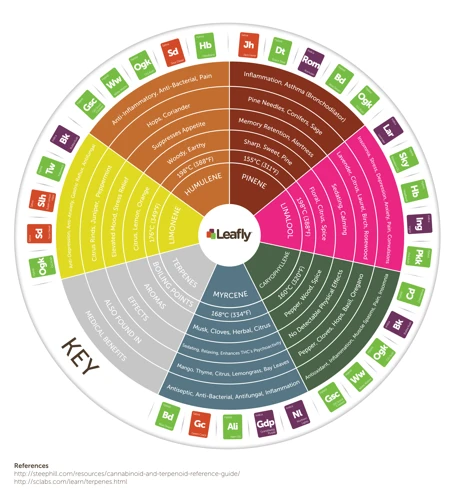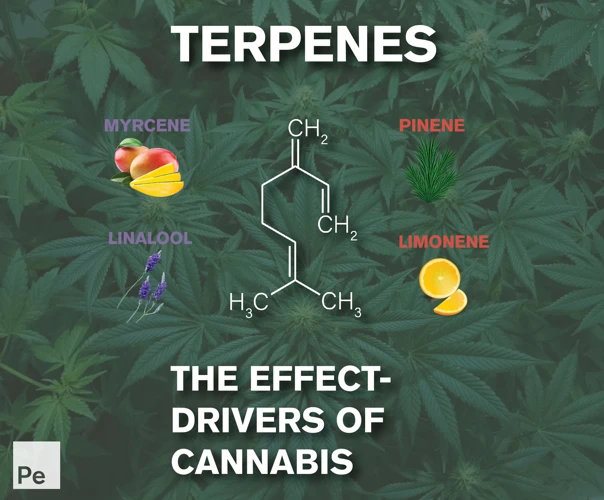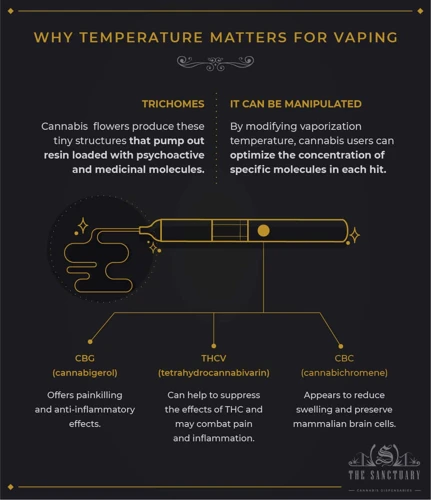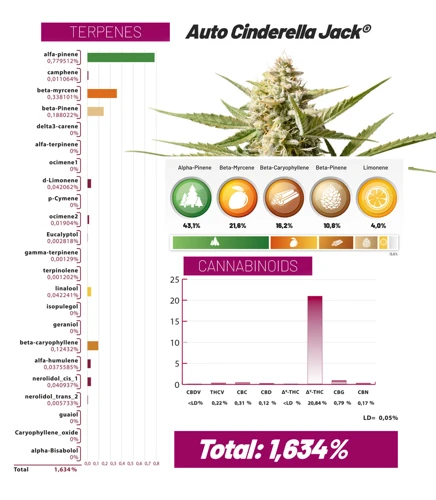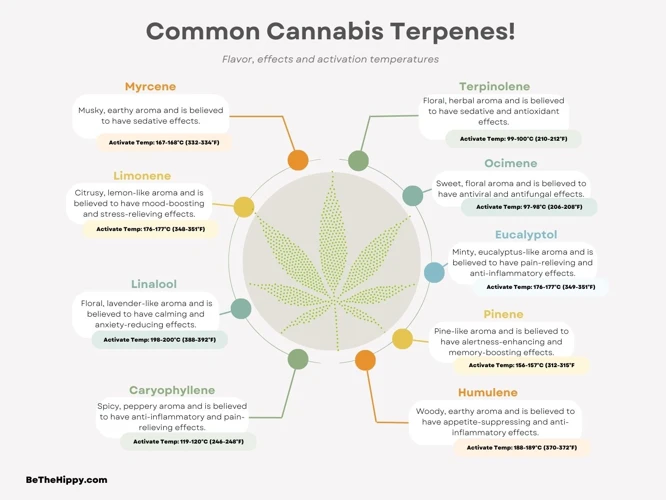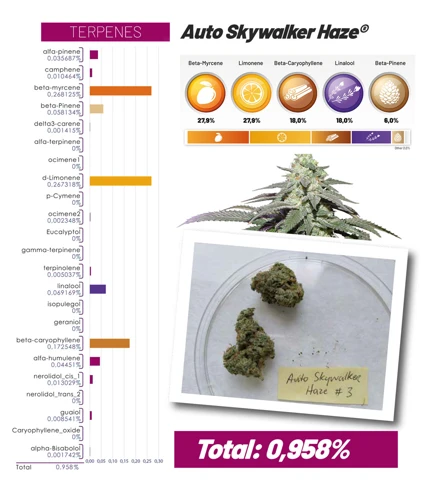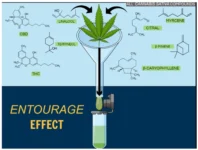
How Temperature Affects Cannabis Terpenes and Cannabinoids
As the popularity of cannabis continues to soar, the demand for research on its various aspects also increases. One of the most pressing issues that growers face is how temperature affects the production of cannabinoids and terpenes. While there is a lot of information available on the effect of temperature on Cannabis plants, it can be overwhelming to sort through it all. This article sets out to provide a comprehensive guide for growers who wish to optimize the production of their cannabis. We will delve into the science behind terpenes and cannabinoids and the role they play in cannabis. We will also explore the impact that temperature has on cannabis production as well as tips for controlling temperature for optimal results.
What Are Terpenes and Cannabinoids?
Contents
When it comes to cannabis, terpenes and cannabinoids are two words that you’re likely to hear thrown around a lot. These compounds are responsible for the various effects that cannabis has on the body and mind, and understanding what they are and how they work is crucial for any cannabis enthusiast. Terpenes are organic compounds that give cannabis its distinct aroma and flavor, while cannabinoids refer to a group of compounds that interact with the body’s endocannabinoid system to produce various effects. Let’s take a closer look at both of these compounds and what they do.
What Are Terpenes?
Terpenes are a group of organic compounds that are found in various plants, including cannabis. These compounds are responsible for the unique aroma and taste of different strains of cannabis. In addition to their sensory properties, terpenes have been shown to have a variety of therapeutic effects.
Terpenes are produced in the same glandular trichomes as cannabinoids, and are synthesized from the same precursor molecule, isoprene. There are over 20,000 known terpenes, with over 100 found in cannabis.
Table: Common Terpenes Found in Cannabis
| Name | Aroma/Flavor Profile | Therapeutic Effects |
|---|---|---|
| Linalool | Floral, Lavender | Relaxation, Anti-anxiety, Pain relief |
| Myrcene | Earthy, Musky | Sedative, Anti-inflammatory, Antioxidant |
| Caryophyllene | Peppery, Spicy | Anti-inflammatory, Anti-anxiety, Pain relief |
| Pinene | Pine, Woody | Alertness, Memory retention, Bronchodilator |
| Terpinolene | Herbal, Floral | Sedative, Antioxidant, Anti-tumor |
| Humulene | Earth, Woody | Anti-inflammatory, Antibacterial, Appetite suppressant |
The presence and concentration of terpenes can vary depending on a variety of factors, including genetics, climate, and growing conditions. The interactions between terpenes and cannabinoids are thought to play a significant role in the overall effects of different strains of cannabis, an effect known as the entourage effect.
In addition to their effects on humans, terpenes also play a role in protecting the cannabis plant from pests and predators. Some terpenes, such as limonene and pinene, have been shown to have insecticidal properties, while others, such as caryophyllene, repel mites and fungus gnats.
Terpenes are an important component of cannabis, contributing to both its unique aroma and potential therapeutic effects.
What Are Cannabinoids?
Cannabinoids: the chemical compounds found in cannabis plants that interact with our bodies in various ways. There are over 100 cannabinoids, but the two most well-known and studied ones are THC (Tetrahydrocannabinol) and CBD (Cannabidiol).
| Cannabinoids | Description |
|---|---|
| THC | A psychoactive compound that stimulates the release of dopamine, creating a feeling of euphoria or “high”. It also has several therapeutic benefits such as reducing pain, inflammation, and nausea. |
| CBD | A non-psychoactive compound that has several therapeutic benefits such as reducing anxiety, inflammation, and pain. It also counteracts the psychoactive effects of THC. |
| CBC | A non-psychoactive cannabinoid that has several therapeutic benefits such as reducing pain, inflammation, and combating bacterial and fungal infections. |
| CBN | A mildly psychoactive cannabinoid that is formed from the degradation of THC. It has sedative effects and is commonly used as a sleep aid. |
| CBG | A non-psychoactive cannabinoid that is a precursor to THC, CBD, and CBC. It has several therapeutic benefits such as reducing inflammation, pain, and promoting bone growth. |
Cannabinoids interact with our Endocannabinoid System, which plays a crucial role in regulating a variety of physiological processes such as mood, appetite, pain, and immune function. The Endocannabinoid System consists of three components: endocannabinoids, receptors, and enzymes. When cannabinoids are consumed, they bind to receptors in our body and produce various effects. Different cannabinoids have different binding affinities to these receptors, which leads to various effects in the body. The ratio of THC to CBD in a strain of cannabis can greatly affect the overall effects experienced by the consumer.
The Role of Terpenes and Cannabinoids in Cannabis
Cannabis is a plant with numerous chemical components, the two most well-known being terpenes and cannabinoids. Both of these compounds have a vital role to play in the effects that cannabis produces. Terpenes contribute to the plant’s aroma and flavor, while cannabinoids dictate its psychoactive effects. In this section, we will explore the respective roles of terpenes and cannabinoids in cannabis and how they work together to produce the desired effects. Understanding these components is key to optimizing the temperature for growing cannabis.
What Are the Effects of Terpenes?
Terpenes are organic compounds found in plants, including cannabis. They are responsible for the characteristic aroma and flavor of the plant, which can vary from strain to strain. However, terpenes not only contribute to the sensory experience of consuming cannabis, but they also play a role in the overall effects of cannabis consumption.
Below is a table summarizing the effects of some commonly found terpenes in cannabis:
| Terpene | Flavor/ Aroma | Effects/ Benefits |
|---|---|---|
| Myrcene | Musky, earthy, and herbal | Sedative, Deep relaxation, Pain relief, Anti-inflammatory, Anti-cancer properties |
| Pinene | Pine, fresh, and herbal | Elevates mood, Sharpens focus, Respiratory aid, Anti-inflammatory, Anti-bacterial properties |
| Limonene | Citrus, lemon, and floral | Elevates mood, Reduces stress/anxiety, Anti-depressant, Respiratory aid, Anti-inflammatory, Anti-cancer properties |
| Caryophyllene | Peppery, spicy, and woody | Analgesic, Anti-inflammatory, Anti-anxiety, Anti-depressant, Anti-cancer properties |
| Linalool | Floral, lavender, and spicy | Relaxation, Sleep aid, Anti-anxiety, Anti-inflammatory, Analgesic, Anti-epileptic, Anti-depressant properties |
| Humulene | Herbal, earthy, and spicy | Anti-inflammatory, Anorectic, Analgesic, Anti-bacterial, Anti-tumor |
As you can see, terpenes can have diverse effects, ranging from pain relief and relaxation to anti-inflammatory and anti-cancer properties. Understanding the impact of terpenes can help cannabis users choose strains that meet specific therapeutic needs. Along with the cannabinoids, terpenes contribute to the overall entourage effect of cannabis consumption, which means that the combined effects of cannabinoids and terpenes are greater than the sum of their individual effects.
What Are the Effects of Cannabinoids?
Cannabinoids are the chemical compounds that interact with the receptors in our bodies and produce various effects. Here are some of the known effects of cannabinoids:
| Effect | Cannabinoid |
|---|---|
| Relief of pain and inflammation | THC, CBD, CBG, CBC |
| Relaxation and sedation | THC, CBN |
| Euphoria and mood enhancement | THC |
| Appetite stimulation and anti-nausea | THC, CBD |
| Reduced anxiety and depression | CBD, CBG, THCV |
| Improved focus and alertness | THC, CBDV |
| Antioxidant and neuroprotective | CBD, CBG, CBC |
THC is the most well-known cannabinoid and is known for producing the psychoactive effects commonly associated with cannabis use. CBD is another popular cannabinoid that does not produce psychoactive effects but has been shown to have numerous therapeutic properties.
CBG, CBC, and THCV are lesser-known cannabinoids that are being studied for their potential therapeutic benefits.
It is important to note that the effects of cannabinoids can vary depending on the individual’s tolerance, dosage, and mode of consumption (smoking, edibles, tinctures, etc.). Additionally, the effects can be modulated by the presence of terpenes and other compounds in the cannabis plant.
How Temperature Affects Terpenes and Cannabinoids
The relationship between temperature and cannabis cultivation is complex and multifaceted. While temperature plays a critical role in the growth and development of cannabis plants, it also has a significant impact on the production of terpenes and cannabinoids. These two compounds are essential to the medicinal and recreational benefits of cannabis and provide a range of unique effects. The interplay between temperature and terpenes and cannabinoids is a topic of ongoing research and debate within the cannabis community, as different cultivators and scientists work to develop the optimal conditions for growth and the most effective methods of cannabis consumption. In this section, we will explore the impact of temperature on terpenes and cannabinoids in greater depth, and examine how cultivators can maximize the production of these crucial compounds through careful temperature control.
Terpenes and Temperature
Terpenes, the organic compounds responsible for the characteristic aroma and flavor of cannabis, can be affected by temperature. Here are some ways in which temperature affects terpenes:
- Boiling Point: Each terpene has its own boiling point, which can range from 310°F to over 700°F. At higher temperatures, some terpenes may evaporate or degrade, resulting in a loss of aroma and flavor.
- Activation: Heat can also activate terpenes, making them more volatile and enhancing their aroma and flavor. This is why cannabis buds may smell stronger when they are heated or burned.
- Fractionation: Through a process called fractionation, terpenes can be selectively extracted and isolated based on their different boiling points. By controlling the temperature, it’s possible to extract specific terpenes from cannabis to make concentrates or extracts with distinct flavors and aromas.
- Degradation: High temperatures can also cause terpenes to degrade, resulting in a loss of potency and aroma. This is why it’s important to control the temperature during the extraction process to preserve the terpenes and cannabinoids.
Temperature plays an important role in the potency, aroma, and flavor of cannabis. By carefully controlling the temperature during different stages of growth and processing, it’s possible to maximize the production of terpenes and cannabinoids and create high-quality cannabis products.
Cannabinoids and Temperature
Cannabinoids, like terpenes, are highly affected by temperature. However, unlike terpenes, which are more volatile and can evaporate easily, cannabinoids are more stable and less prone to evaporation. Nevertheless, temperature is still a critical factor for cannabinoid production, as the levels of different cannabinoids can vary greatly depending on the temperature.
| Cannabinoid | Temperature Range | Effect of Temperature |
|---|---|---|
| THCA | 20-35 °C | Optimal temperature range for THCA production during the vegetative stage. |
| THC | 50-60 °C | Decarboxylation occurs at this temperature range, which converts THCA to THC, the psychoactive compound. |
| CBD | 160-180 °C | The optimal temperature range for CBD production during the flowering stage. |
| CBC | 220-280 °C | Higher temperatures are needed for CBC production, making it less desirable for most growers. |
It is important to note that while some cannabinoids have optimal temperature ranges for production, excessively high temperatures can degrade or destroy cannabinoids. With THC, for example, exposure to temperatures above 70°C (158°F) can result in its breakdown and loss of potency.
Controlling the temperature during the flowering stage is particularly important for cannabinoid production, especially for CBD, which is being increasingly researched for its potential medical benefits. During this period, it is recommended to maintain temperatures between 18-26°C (64-78°F) during the day and 15-20°C (59-68°F) at night.
Balancing the temperature in cannabis cultivation is essential to maximize the potency and quality of the end product. Careful control of temperature throughout different stages of growth can be achieved through the use of appropriate temperature control devices and systems.
How to Control Temperature for Optimal Terpene and Cannabinoid Production
Controlling temperature is crucial for achieving optimal terpene and cannabinoid production in cannabis plants. The temperature needs to be carefully monitored and maintained throughout the various stages of growth to ensure the best quality and quantity of these compounds. In this section, we will explore some of the methods that can be used to control the temperature, both indoors and outdoors, for the best possible results. From investing in thermometers to considering the location of your grow room and using temperature control devices, these tips will help you achieve the perfect conditions for cannabis cultivation.
Indoor Cannabis Growing
Indoor cannabis growing is the most popular method among cannabis cultivators, as it provides better control over environmental conditions, including temperature, humidity, and light. Here are some tips for maintaining optimal temperature levels during indoor cannabis cultivation:
- Choose the right grow light: Different grow lights produce different levels of heat, and it’s important to choose one that doesn’t produce excessive heat which can damage or stress the plants. LED grow lights, for instance, emit less heat than High-Pressure Sodium (HPS) lights.
- Use air conditioning: If the ambient temperature is too high, consider using an air conditioner to lower it. This can also help reduce the humidity level, which can also affect plant growth.
- Monitor temperature levels: Use a thermometer to monitor temperature levels inside the grow room. Keep the temperature between 20-28°C (68-82°F) during the vegetative stage and between 20-26°C (68-78°F) during the flowering stage.
- Ensure proper air circulation: Good air circulation can help distribute heat evenly and reduce hot spots that can damage plants. Use fans and ventilation systems to create a cross breeze and circulate air within the grow room.
- Insulate the grow room: Insulating the walls, floors, and ceiling of the grow room can help maintain temperature levels and reduce energy costs of temperature regulation.
- Avoid temperature fluctuations: Constant changes in temperature can stress and damage plants, so it’s important to avoid sudden changes in temperature. Keep the temperature stable and consistent throughout the growing cycle.
Following these tips can help indoor growers maintain optimal temperature levels that promote healthy and vigorous growth of cannabis plants, leading to higher yields and better quality buds with optimal terpene and cannabinoid levels.
Outdoor Cannabis Growing
When growing cannabis outdoors, temperature control may seem challenging. However, there are a few things you can do to ensure that terpenes and cannabinoids are produced in optimal quantities despite temperature fluctuations. Here are some tips for outdoor cannabis growing:
- Choose the Right Strain – Different strains have different temperature requirements. Some strains are better suited for hot and dry climates and others for cooler and humid conditions. Research the temperature requirements of the strain you want to grow to make sure it’s suitable for the outdoor climate in your area.
- Timing – Timing is crucial in outdoor cannabis growing. It’s important to plant the seeds at the right time when the temperature is optimal for germination. You should plant your cannabis in a spot with good exposure to sunlight, as this will help to regulate the temperature.
- Watering Techniques – Proper watering is essential to maintaining consistent soil temperature. Over-watering can lead to the soil becoming cold and slow down the growth process. Additionally, it’s best to water cannabis in the early morning or late evening, as this is when temperatures are cooler.
- Mulching – Mulching is an effective way to regulate soil temperature. A layer of mulch on top of the soil can help to insulate the plant roots from extreme temperature changes.
- Shade Cloth – A shade cloth can be used to help regulate temperatures if it gets too hot during the day. The shade cloth will also protect the plants from UV rays, which can be harmful to cannabis plants.
- Windbreaks – Wind can be a problem for outdoor cannabis growers. It dries out the soil and can damage the plants. Building a barrier around your plants, such as a fence or wall can help to block the wind and regulate temperature more effectively.
By following these tips, you can increase the chances of producing cannabis with optimal terpene and cannabinoid levels, even when growing outdoors where the temperature can fluctuate.
Effects of temperature on different stages of cannabis growth
As cannabis cultivation gains popularity, more growers are becoming curious about the impact of temperature on the different stages of growth. The germination, vegetative, flowering, and harvest stages of cannabis growth are all affected by temperature changes. Controlling the temperature is crucial to ensure optimal terpenes and cannabinoids production, as well as for overall plant health. In this section, we will explore the effects of temperature on each stage of cannabis growth and how to maintain the perfect temperature for an abundant and potent harvest.
Seed Germination
During the seed germination stage, temperature plays a crucial role in determining the success of the process. Too low or too high temperature can hinder germination, which can affect the growth of the plant later on. The ideal temperature for seed germination is around 70-75°F. Here are some important things to keep in mind for temperature control during the seed germination stage:
- Use a Seedling Heat Mat: A seedling heat mat is a great investment for maintaining an optimal temperature for germination. This mat provides extra warmth and helps maintain a consistent temperature, which can increase the success rate of germination.
- Avoid Direct Sunlight: Direct sunlight can increase the temperature of the germination area, which can be harmful to the seeds. It is best to keep the seeds away from direct sunlight and instead use a grow light to control the temperature.
- Monitor Temperature: It is important to monitor the temperature of the germination area regularly. Use a thermometer to check the temperature at regular intervals and adjust the temperature control devices as necessary.
Keeping these factors in mind can help ensure optimal temperature control during the seed germination stage, which can lead to successful germination and a healthy cannabis plant in the future.
Vegetative Stage
During the vegetative stage, cannabis plants are focused on growing and developing strong stems and a healthy root system. This stage typically lasts for 4-6 weeks and requires a temperature range of 70-85°F during the day and 58-70°F at night for optimal growth.
Maintaining the right temperature during this stage is crucial to ensure that the plants grow properly and do not become stunted or too stretched out. Stunted growth can occur if the temperature is too low, while overheating can result in stretching and weak stems.
Effects of High Temperature
During the vegetative stage, high temperature can cause several negative effects on the cannabis plants. These include:
| Effect | Symptoms |
| Stunted Growth | Plants stop growing and appear stunted |
| Root Damage | Roots become brittle and stop growing, causing nutrient uptake issues |
| Wilting | Plant leaves droop and appear wilted |
| Heat Stress | Plant leaves appear yellow and burnt, with brown spots or edges |
Effects of Low Temperature
On the other hand, low temperature can also have negative effects on the cannabis plants during the vegetative stage. These include:
| Effect | Symptoms |
| Slow Growth | Plants grow slowly and may appear stunted |
| Root Rot | Roots become waterlogged and rot, causing nutrient uptake issues |
| Pest Infestations | Cold temperatures can attract pests such as spider mites and whiteflies |
| Poor Nutrient Uptake | Plants may struggle to take up nutrients, leading to nutrient deficiencies |
Maintaining the right temperature during the vegetative stage is essential for healthy and vigorous growth. It is important to monitor the temperature closely and make adjustments as needed to ensure that the plants are growing optimally.
Flowering Stage
During the flowering stage, the buds of the cannabis plant begin to develop and mature. This is a critical stage for terpene and cannabinoid production as this is when the highest concentration of these compounds are present.
The Effects of Temperature During Flowering Stage
Temperature can have a significant impact on the production of terpenes and cannabinoids during the flowering stage. If the temperature is too hot, the terpenes can evaporate, leading to a loss of flavor and aroma. On the other hand, if the temperature is too cold, the cannabinoids may not fully develop, leading to a decrease in potency.
Below is a table outlining the effects of temperature on terpenes and cannabinoids during the flowering stage:
| Temperature Range | Effects on Terpenes | Effects on Cannabinoids |
|---|---|---|
| Below 60°F | Decreased Terpene Production | Decreased Cannabinoid Production |
| 60°F – 70°F | Optimal Terpene Production | Optimal Cannabinoid Production |
| Above 85°F | Terpene Evaporation | Reduced Cannabinoid Potency |
Controlling Temperature During Flowering Stage
To achieve optimal terpene and cannabinoid production during the flowering stage, it is important to control the temperature. This can be achieved through the following methods:
- Using a thermometer: Regularly monitoring the temperature can ensure that it stays within the optimal range.
- Using an air conditioning unit: If the temperature is too hot, an air conditioning unit can be used to bring it down to the optimal range.
- Using a heater: If the temperature is too cold, a heater can be used to bring it up to the optimal range.
- Using proper insulation: Proper insulation can help maintain a stable temperature within the growing area.
- Using LED grow lights: LED grow lights produce less heat than traditional grow lights, which can help maintain a stable temperature.
Controlling the temperature during the flowering stage is crucial for the optimal production of terpenes and cannabinoids. By monitoring and adjusting the temperature as needed, growers can ensure a high-quality and potent cannabis harvest.
Harvest Stage
During the harvest stage, it’s crucial to maintain optimal temperatures to preserve the quality of your cannabis terpenes and cannabinoids. Harvesting your cannabis at the right time and temperature is essential to getting the most out of your crop.
When it comes to temperature during the harvest stage, there are two main factors to consider: room temperature and humidity levels. If the room is too warm or humid, it can cause mold and mildew to grow, which can ruin your cannabis crop.
The ideal temperature for harvesting cannabis is between 64°F to 75°F (18°C to 24°C). At this temperature, the terpenes are preserved, and the buds will maintain their quality. Anything above or below this range can cause damage to the trichomes and reduce the potency and flavor of the buds.
Humidity is another important factor during the harvest stage. The ideal humidity level for drying cannabis is between 45% and 55%. If the humidity is too high, it can cause mold and mildew to grow on the buds. If the humidity is too low, the buds will dry out too quickly and lose their flavor and potency.
To ensure optimal temperature and humidity levels during the harvest stage, it’s essential to invest in a quality thermometer and hygrometer. This will help you monitor the temperature and humidity levels in your grow room and make adjustments as needed.
Maintaining the proper temperature and humidity levels during the harvest stage is crucial for preserving the quality of your cannabis terpenes and cannabinoids. Keep the room temperature between 64°F to 75°F (18°C to 24°C) and humidity between 45% and 55% to achieve the best results.
Best Temperature for Optimal Terpenes and Cannabinoids Production
Achieving optimal temperature for cannabis cultivation is crucial for the production of high-quality terpenes and cannabinoids. The ideal temperature range for cannabis cultivation is between 18°C to 30°C. This temperature range ensures that terpenes and cannabinoids are produced in optimal quantities.
Temperatures that are too high or too low can negatively impact the production of terpenes and cannabinoids. Temperatures that are too high can cause the breakdown of terpenes and cannabinoids, resulting in a loss of these valuable compounds. On the other hand, temperatures that are too low can slow down the growth of the cannabis plant and reduce the production of terpenes and cannabinoids.
The best temperature for optimal terpene production is between 20°C to 30°C. Temperatures within this range stimulate the production of terpenes and enhance their flavors and aromas. Terpenes produced at lower temperatures tend to be more muted, while those produced at higher temperatures can be overpowering.
The ideal temperature range for optimal cannabinoid production is between 22°C to 28°C. Within this temperature range, cannabis plants produce higher levels of THC and other cannabinoids. Temperatures that are too high or too low can cause a decrease in THC levels and alter the effects of the cannabis strain.
It is essential to maintain a consistent temperature throughout the cannabis plant’s growth cycle to ensure optimal terpene and cannabinoid production. Temperature fluctuations can cause stress to the plant, leading to a decrease in the production of these valuable compounds.
The ideal temperature range for optimal terpenes and cannabinoids production is between 18°C to 30°C. Specifically, temperatures between 20°C to 30°C are ideal for terpene production, and 22°C to 28°C are ideal for cannabinoid production. Consistent temperature control is crucial throughout the cannabis plant’s growth cycle to ensure the production of high-quality terpenes and cannabinoids.
Tips for Temperature Control
Maintaining proper temperature control is crucial in cannabis cultivation as it directly impacts the quality and quantity of terpenes and cannabinoids produced. Without appropriate temperature control, the potency and flavor of your cannabis may suffer. We have compiled some crucial tips to help you maintain precise temperature control in your grow room, regardless of the scale of your operation. These tips range from investing in a good quality thermometer to considering an HVAC system or air conditioner for larger operations. By following these tips, you can ensure optimal cannabis growth and maximize your terpene and cannabinoid production.
Invest in a Good Quality Thermometer
One important tip for controlling temperature in cannabis growing is to invest in a good quality thermometer. This will allow you to accurately monitor the temperature in your grow room or outdoor cannabis garden. When choosing a thermometer, it is important to consider the accuracy and reliability of the device.
Accuracy: A thermometer with a high degree of accuracy will provide more precise readings of the temperature in your grow room or outdoor cannabis garden. This is especially important when it comes to adjusting your temperature control devices.
Reliability: It is important to choose a thermometer that is durable and built to last. This will ensure that the device will continue to provide accurate readings over time and withstand the wear and tear of regular use.
When shopping for a thermometer, consider whether you prefer a digital or analog device. Digital thermometers tend to be more precise and easier to read, while analog thermometers are often less expensive and do not require batteries.
Once you have chosen your thermometer, be sure to place it in a central location in your grow room or outdoor cannabis garden. This will help ensure that you get an accurate reading of the overall temperature.
In addition to investing in a good quality thermometer, there are other steps you can take to control the temperature in your cannabis growing space. These include considering the location of your grow room, using a proper ventilation system, insulating your grow room, and using temperature control devices or an HVAC system if necessary.
Consider the Location of Your Grow Room
When it comes to growing cannabis, one crucial factor that can impact the growth and development of your plants is the location of your grow room. Choosing the right location for your grow room is essential for maintaining a consistent temperature and providing your plants with the optimal conditions they need to thrive. Below are some important factors to consider when selecting the location of your grow room:
- Accessibility: Ensure that your grow room is in a location that is easy to access. This will make it easier for you to monitor your plants and maintain the optimal temperature levels.
- Light: Cannabis plants require a lot of light to grow properly, so it’s crucial to select a space that receives adequate sunlight or has an appropriate artificial lighting system.
- Airflow: Proper airflow is critical to maintaining healthy cannabis plants. Make sure the location of your grow room has access to fresh air or has an efficient ventilation system in place.
- Humidity: Cannabis plants thrive in an environment with moderate humidity levels. Consider the location’s humidity levels, and if necessary, install a dehumidifier to keep humidity levels within the optimal range.
- Temperature: As we’ve discussed, maintaining consistent temperature levels is imperative for optimal terpene and cannabinoid production. Choose a location with a stable temperature or implement temperature control devices to maintain optimal temperature levels.
- Security: Growing cannabis may not be legal in all regions, so it’s essential to select a location that is secure and inaccessible to unauthorized individuals. It’s also essential to ensure that your grow room cannot be detected through any ventilation systems or windows.
Considering all these factors when selecting the location of your grow room can help create the ideal environment for your cannabis plants to grow and flourish, ultimately leading to optimal terpene and cannabinoid production.
Use Proper Ventilation System
A proper ventilation system is crucial in maintaining the right temperature and humidity levels for cannabis growth. It helps remove excess heat and moisture from the grow room, preventing the growth of harmful microorganisms that can damage your plants.
There are several types of ventilation systems available for cannabis growers:
| Type of Ventilation System | Advantages | Disadvantages |
|---|---|---|
| Exhaust Fans | Easy to install and use, affordable. | May not be powerful enough for larger grow rooms. |
| Inline Fans | Powerful and efficient, can be used for larger grow rooms, can be attached to a carbon filter for odor control. | More expensive than exhaust fans. |
| Intake Fans | Helps bring in fresh air and maintain carbon dioxide levels for better plant growth. | May not be necessary for smaller grow rooms. |
| Carbon Filters | Eliminates odor and harmful gases from the grow room, can be attached to an inline fan. | May reduce airflow and require regular replacement. |
When choosing a ventilation system, keep in mind:
– The size of your grow room.
– The number of plants you have.
– The amount of light your plants receive.
– The desired temperature and humidity levels.
– Your budget.
It is also important to:
– Clean your ventilation system regularly to prevent buildup of dust and other contaminants.
– Test the ventilation system before introducing plants to ensure it is working properly.
– Monitor temperature and humidity levels regularly to ensure the ventilation system is functioning effectively.
Proper ventilation is a key factor in ensuring optimal growth and production of terpenes and cannabinoids in your cannabis plants.
Insulate Your Grow Room
One important aspect of controlling the temperature in your cannabis grow room is insulation. Proper insulation helps maintain a consistent temperature and avoids temperature fluctuations caused by external factors.
Insulating materials can vary in their effectiveness and cost. The table below provides an overview of common insulation materials, their R-value (a measure of thermal resistance), and their estimated cost per square foot:
| Insulation Material | R-Value | Cost per Square Foot |
|---|---|---|
| Fiberglass batts | 3-4 per inch | $0.50-$1.20 |
| Cellulose insulation | 3.2-3.8 per inch | $0.90-$1.50 |
| Spray foam insulation | 3.6-8 per inch | $1.50-$3.00 |
| Rigid board insulation | 3.8-8 per inch | $1.50-$3.00 |
It is important to calculate the amount of insulation needed for your grow room and choose an appropriate material based on your budget and insulation needs. Consider also the location and size of your grow room. If it is located in a colder area, more insulation may be needed. Also, if the grow room is large, more insulation may be required to maintain a consistent temperature throughout the entire space.
In addition to insulation materials, sealing your grow room is another important aspect of controlling temperature. This includes sealing any cracks or gaps in walls, ceilings, and floors to prevent air leaks. This can be done with caulk or weatherstripping, which will help to maintain a consistent temperature and reduce energy costs.
Proper insulation and sealing can make a significant difference in controlling the temperature in your cannabis grow room. By investing in good insulation and sealing materials, you can save on energy costs and ensure optimal conditions for your plants.
Use Temperature Control Devices
Maintaining a stable temperature is crucial for achieving optimal terpene and cannabinoid production in cannabis. One effective way to control temperature is by using temperature control devices. These devices help to maintain a consistent temperature in your growing environment, whether it’s an indoor or outdoor setup.
Here are a few temperature control devices that you can consider:
- Thermostats: Thermostats are commonly available and can be purchased at reasonable prices. They help regulate temperature by turning on or off heating or cooling devices such as fans or heaters. By setting up a temperature range, the thermostat maintains consistent temperatures within the range. Some high-end thermostats even provide real-time temperature updates and can be controlled remotely via smartphone or other devices.
- Humidifiers and Dehumidifiers: Humidity levels are also important in cannabis growth, and they can affect terpene and cannabinoid production. Using humidifiers and dehumidifiers helps control the level of moisture in the growing environment, which ultimately affects the temperature. By using these devices, you can ensure that humidity levels remain optimal for growth and that the temperature stays stable.
- Air Conditioners: Air conditioners are necessary for maintaining cool temperatures during hot summer months. They are more commonly used in indoor growing environments and are ideal for maintaining the temperature between 68-77°F (20-25°C). Some modern air conditioners even have in-built thermostats that can be set to maintain specific temperatures.
- Heaters: Heaters are used to control temperatures during colder months of the year. By using a heater, you can maintain a stable temperature in your growing environment and prevent damage to your plants. There are many different types of heaters available, including gas, electric, and oil heaters, so make sure to choose one that suits your specific setup.
- Ventilation and Exhaust Systems: Using ventilation and exhaust systems can help control the temperature as well as humidity levels in your growing environment. These systems help to circulate the air, which prevents hot spots and ensures uniform temperature distribution. The systems also help remove excess humidity, promote healthy plant growth and prevent the buildup of harmful pathogens in the environment.
Using temperature control devices is an effective way to maintain optimal temperature and humidity levels for cannabis growth. By investing in these devices, you can ensure that your plants receive the best possible environment for optimal terpene and cannabinoid production.
Consider Investing in a HVAC System or Air Conditioner if Necessary
Maintaining the ideal temperature for cannabis growth is crucial for optimal terpene and cannabinoid production. In some cases, especially in areas where the climate is not favorable, investing in a HVAC (heating, ventilation, and air conditioning) system or an air conditioner may be necessary to regulate the temperature in the grow room.
Here are some reasons why investing in a HVAC system or air conditioner may be necessary:
- External Temperature: If the external temperature is too high or too low, it can be difficult to maintain an optimal temperature in the grow room without a proper HVAC system or air conditioner.
- Humidity: High humidity levels can cause the temperature to rise, making it uncomfortable for the plants to grow. In some cases, the humidity levels may be too high even with a dehumidifier, and an air conditioner may be necessary to regulate the temperature.
- Indoor Lighting: Grow lights can emit a lot of heat, which may cause the temperature in the grow room to rise. An air conditioner or proper ventilation system can help to address this issue.
When considering investing in a HVAC system or air conditioner, here are a few things to keep in mind:
- Size of Grow Room: The size of the grow room will determine the size of the HVAC system or air conditioner needed. It is important to choose an appropriately sized system to ensure proper temperature regulation.
- Energy Efficiency: Investing in an energy-efficient HVAC system or air conditioner can save money on energy costs in the long-term. It is important to research different options and choose the most energy-efficient option for your needs.
- Maintenance: HVAC systems and air conditioners require regular maintenance to continue working effectively. It is important to consider the maintenance requirements and factor that into the overall cost of the system.
Investing in a HVAC system or air conditioner may seem like a big expense, but it can be essential for maintaining optimal temperature conditions for cannabis growth. It is important to carefully consider the factors listed above and choose the best option for your specific grow room and needs.
Conclusion
In conclusion, it is evident that temperature plays a crucial role in the production of terpenes and cannabinoids in cannabis plants. Terpenes are responsible for the aroma and flavor of cannabis, while cannabinoids are responsible for its effects. The ideal temperature for the production of terpenes and cannabinoids varies depending on the stage of growth.
It is important to control the temperature in both indoor and outdoor cannabis cultivation. Indoor growers should invest in a good quality thermometer, consider the location of their grow room, use a proper ventilation system, insulate the grow room, and use temperature control devices. Outdoor growers should focus on choosing the right location and planting at the right time to take advantage of the optimal temperature conditions.
Temperature also affects different stages of growth, from seed germination to harvest. Growers should be mindful of the ideal temperature for each stage to ensure the optimal production of terpenes and cannabinoids.
In summary, temperature control is essential for achieving the best quality and quantity of cannabis terpenes and cannabinoids. With proper temperature control, growers can optimize their yields and produce cannabis with desirable aroma, flavor, and effects. As the cannabis industry continues to grow, it is crucial to continue researching and understanding the impact of temperature on cannabis cultivation.
Frequently Asked Questions
Can temperature affect the smell and taste of cannabis?
Yes, temperature can have a significant impact on the smell and taste of cannabis due to the presence of terpenes, which are responsible for the unique aroma and flavor of each strain.
Is it better to grow cannabis indoors or outdoors for optimal terpene and cannabinoid production?
It depends on various factors, but both indoor and outdoor cultivation methods can yield high-quality cannabis with optimal terpene and cannabinoid production.
Why are terpenes important in cannabis?
Terpenes play a vital role in the unique aroma, flavor, and effects of each cannabis strain. They can also have therapeutic benefits when consumed with cannabinoids.
What is the best temperature for optimal terpene and cannabinoid production in cannabis?
The ideal temperature range for optimal terpene and cannabinoid production in cannabis is between 18-29°C (64-84°F).
How can I control the temperature for cannabis cultivation?
You can control the temperature for cannabis cultivation by investing in a good quality thermometer, location selection, using proper ventilation system, insulating your grow room, using temperature control devices, and considering investing in an HVAC system or air conditioner if necessary.
Does temperature affect the potency of cannabis?
Yes, temperature can affect the potency of cannabis due to its impact on the biosynthesis of cannabinoids and terpenes.
What are the best temperature control devices for cannabis cultivation?
The best temperature control devices for cannabis cultivation include thermostats, hygrostats, and humidity controllers.
Can too much heat damage my cannabis plants?
Yes, too much heat can cause damage to cannabis plants, leading to reduced growth and yield, nutrient deficiencies, and even death in severe cases.
Can temperature affect the color of cannabis buds?
Yes, temperature can affect the color of cannabis buds, with higher temperatures potentially leading to darker, brownish-colored buds.
Why do different strains of cannabis have different effects?
Different strains of cannabis have varying effects due to their unique combination of terpenes and cannabinoids, which can interact differently with the human body’s endocannabinoid system.

